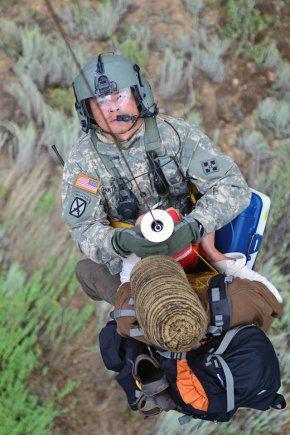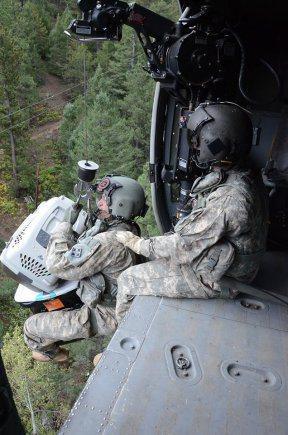
US Army: Three Army Medicine MedEvac crews from Fort Carson (Colorado) deployed to flood areas this week to assist in evacuation and rescue efforts.
They joined members of the Colorado and Wyoming National Guard, Federal Emergency Management Agency, and other local emergency response teams in support of flood evacuation operations.
According to Lance Blyth, U.S. Northern Command historian, the military response to the Colorado floods, dubbed “Operation Centennial Raging Waters,” is likely to be the biggest rotary-wing airlift mission since Hurricane Katrina.
Operating out of Boulder Municipal airport, the MedEvac crews equipped with three Black Hawk and four Chinook helicopters flew upwards of 9.5 hours each on a single Saturday evacuation event before running out of daylight, and crew endurance. From Friday evening through Tuesday, flight crews completed several rounds of non-stop evacuations and 2nd Battalion, 4th Aviation Regiment, rescued/evacuated 1028 civilians and flew over 150 total flight hours.

Charlie Company Archangels flew over 75 flight hours and conducted 43 hoist missions, most of which included five or more lifts per mission in order to clear evacuation sites of all personnel, pets, and baggage. A total of 3,054 people were evacuated by military personnel as of mid September.
At the time, authorities were reporting more than 1,000 individuals were still unaccounted for, which increased concern that flight crews would start seeing patients by the time the mission was complete.
“Thus far, none of the evacuees were the result of injuries directly related to the flooding; however, there were many who had chronic injuries or illnesses that required attention, especially among the elderly,” said Maj. Seth O. Swartz, MedEvac commander, 2-4 General Support Aviation Battalion, and native of Kalamazoo, Michigan.
At the time, Swartz was en route to check on his crews and get a better sense of the scope and duration of what he could expect in the days ahead.
“The mission was limited to daytime operations only, due to the combination of weather through the weekend and the challenges inherent in flying and conducting hoist extractions in mountainous terrain,” said Swartz.
This was coupled with challenges associated with mountain search and rescue where there is no one on the ground in these isolated areas to identify their locations or call the crews in for help.
The rain began earlier in the week, but by Wednesday night had picked up tempo, dropping as much as 10 inches in parts of the state known as the Front Range, which is the most populous area in the instate region. It is the home of such famous cities as Denver, Aurora and Boulder, as well as the smaller municipalities in the hills.
Hooah!
DCG

